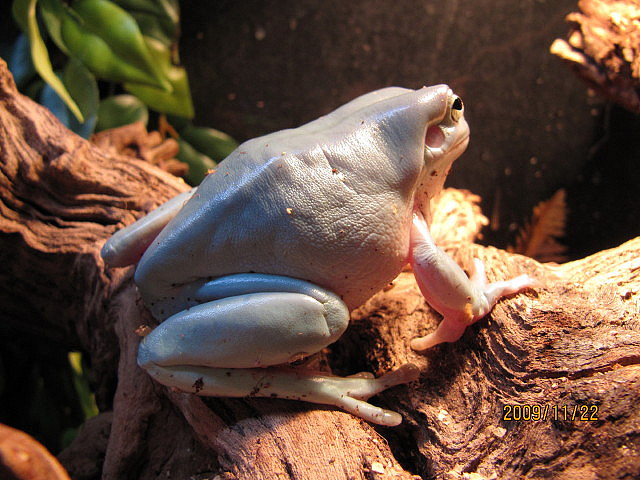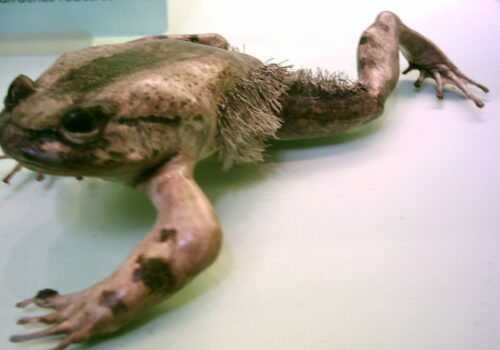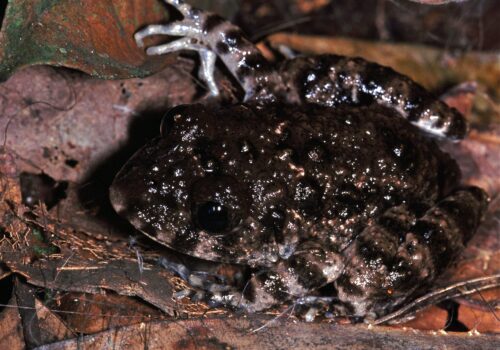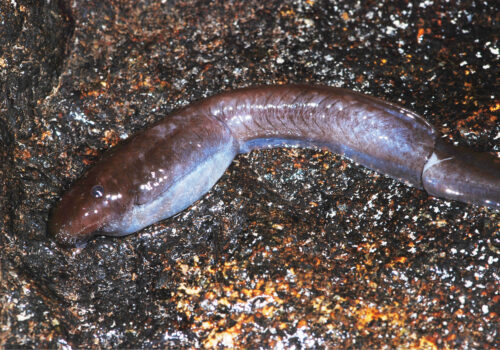- Exploring the Enigmatic Long-Toed Tree Frog: A Closer Look at <em>Leptopelis xenodactylus</em>
- Taxonomy and Classification: Untangling the Web of Amphibian Relations
- Natural Habitat: Life Amidst the Misty Mountains and Lush Afrotropical Forests
- Physical Characteristics: A Mastered Art of Camouflage and Elegance
- Behavior and Life Cycle: The Quiet Rhythm of Forest Life
- Ecological Role: Guardians of Balanced Ecosystems
- Threats and Conservation Status: Navigating Turbulent Times in Fragile Forest Habitats
- Cultural and Scientific Significance: Connecting Communities, Cultivating Understanding
- Conclusion: A Partnership for Preservation and Learning
Exploring the Enigmatic Long-Toed Tree Frog: A Closer Look at Leptopelis xenodactylus#
Hidden within the lush montane rainforests and verdant woodlands of East-Central Africa lives a creature of quiet mystery and delicate beauty—the Long-Toed Tree Frog, scientifically known as Leptopelis xenodactylus. Often overshadowed by more flamboyant species or larger charismatic fauna, this unique little frog holds subtle secrets, adaptations, and ecological significance that warrant greater admiration and understanding. The Long-Toed Tree Frog’s very name hints at its curious adaptation: remarkably elongated digits that allow it to deftly navigate the intricate puzzle of its arboreal world. But beyond its distinctive physical traits, this amphibian embodies the fragile beauty and crucial interconnectedness of its rainforest home.
In this article, we will immerse ourselves deeply into the hidden world of Leptopelis xenodactylus, exploring its taxonomy, its enchanted habitats, life strategies, ecological roles, as well as the pressing conservation challenges it now faces. Along the way, we’ll reveal the understated charm that has intrigued naturalists and inspired researchers alike, shedding light on a remarkable species that deserves our shared protection and appreciation.
Taxonomy and Classification: Untangling the Web of Amphibian Relations#
Leptopelis xenodactylus, commonly known as the Long-Toed Tree Frog, belongs to the family Arthroleptidae, within the expansive order of Anura—the taxonomic grouping encompassing frogs and toads. Specifically, within this diverse amphibian family, this species falls under the genus Leptopelis, a group commonly referred to as tree frogs due to their predominantly arboreal lifestyles.
The genus Leptopelis, containing nearly 50 species dispersed across sub-Saharan Africa, illustrates extraordinary variety in size, coloration, and ecological niches. Within this diverse lineage, Leptopelis xenodactylus shares close evolutionary ties with cousins like Leptopelis karissimbensis and Leptopelis kivuensis, which similarly inhabit Central and East African high-altitude forests.
Natural Habitat: Life Amidst the Misty Mountains and Lush Afrotropical Forests#
The Long-Toed Tree Frog resides primarily in montane forests and high-altitude woodlands of Rwanda, Burundi, Uganda, and the Democratic Republic of Congo, a region renowned for rich biodiversity. These forests, draped in perpetual mist and cloaked in layered vegetation, provide an optimal home for these amphibians, bestowing both concealment and access to food resources.
The Montane Forest Canopy: A Symphony in Green#
Within these mountainous realms, canopy layers form an intricate vertical world—a green tapestry interwoven by creeping vines, ferns, orchids, and moss-covered branches. It is within such shady leaf shelters and slender branches strewn overhead that you may glimpse the elusive silhouette of the Long-Toed Tree Frog expertly maneuvering through the trees.
This arboreal lifestyle is perfectly attuned to the frog’s physiology; their extended digits enable effortless grasping of branches, providing a nimble agility essential for movement in tree canopies. These frogs rarely descend to the forest floor, where predation risks escalate substantially, preferring instead the safety and abundance of treetops.
Physical Characteristics: A Mastered Art of Camouflage and Elegance#
The Long-Toed Tree Frog is characterized primarily by elegant proportions—compact yet graceful—with a body length typically ranging from 30 to 45 millimeters. But the most visually arresting feature, giving this species its distinctive name, lies in its exceptionally elongated fingers equipped with adhesive pads. These specialized appendages offer unparalleled climbing ability and stability, creating graceful ease within complex arboreal terrains.
Colors That Whisper#
Its coloration is a refined subtlety designed unquestionably by nature to blend invisibly against verdant forest vegetation. Commonly, their bodies exhibit varying shades of earthy olive green, leaf brown, or muted yellows speckled with darker markings—all colors tailored by evolution to render these frogs nearly indistinguishable from their lush backgrounds.
The species’ eyes are notably large, forward-facing, and flecked with gold undertones. Large irises enhance nocturnal vision, crucial for spotting prey under diminished moonlight within their nocturnal activity patterns.
Behavior and Life Cycle: The Quiet Rhythm of Forest Life#
As nocturnal creatures, Long-Toed Tree Frogs lead secretive lives, waking at dusk to navigate the canopy paths in search of sustenance. Their evenings unfold quietly, subtly orchestrated by the soft rustling of tree foliage or distant trills echoing through the mist-laden air.
Feeding Habits and Foraging Strategies#
These skilled climbers are opportunistic predators, primarily preying upon small arthropods and insects such as flies, beetles, spiders, and leafhoppers. Their elongated limbs and sticky finger pads give them a distinct hunting advantage, allowing fluid, silent approach toward prey, ensuring successful ambushes on elusive insects.
Courtship Calls and Reproduction#
During mating seasons, males occupy strategic positions high in trees or prominently placed vegetation, serenading females with unique, pulsating melodies resonating smoothly through humid, montane air. These calls display territorial assertiveness and entice receptive females toward mating grounds.
Females deposit gelatinous egg masses strategically positioned on leaves directly over water bodies, typically ephemeral ponds fed by mountain streams or rainfall. This placement guarantees tadpole hatchlings readily fall directly into safe, nourishing water below, maximizing survival potential. After several weeks, the tadpoles undergo remarkable transformations, gradually assuming adult arboreal habits and ascending into their forest kingdom.
Ecological Role: Guardians of Balanced Ecosystems#
Leptopelis xenodactylus contributes significantly to ecosystem health, primarily serving as both predator and prey within intricate forest food webs. They regulate insect and invertebrate populations, indirectly aiding forest health by limiting potential overpopulation and disease transmission.
Simultaneously, their presence benefits larger predators like birds, snakes, and mammals, supplying essential protein-rich meals within broader ecological dynamics. Importantly, the Long-Toed Tree Frog serves as a reliable bioindicator species, their documented decline highlighting underlying environmental stresses experienced by sensitive forest habitats.
Threats and Conservation Status: Navigating Turbulent Times in Fragile Forest Habitats#
Despite their unique ecological niches and fascinating biology, the Long-Toed Tree Frog faces increasingly dire conservation threats. The IUCN Red List currently categorizes Leptopelis xenodactylus as “Vulnerable,” highlighting significant population declines driven primarily by ongoing habitat destruction.
Deforestation and Climate Pressures#
The primary threat plaguing this species arises from escalating deforestation within mountainous regions primarily driven by agriculture expansion, timber extraction, and charcoal production. Fragmentation interrupts connectivity between populations, limiting genetic diversity, impairing dispersal, and amplifying vulnerability to extinction events.
Moreover, climate change is ushering alterations in rainfall patterns, temperature shifts, and humidity fluctuations within forest ecosystems, undermining the delicate balance needed for frogs to thrive and reproduce.
Cultural and Scientific Significance: Connecting Communities, Cultivating Understanding#
While cultural traditions in regions inhabited by the Long-Toed Tree Frog often incorporate amphibians as symbols of renewal and fertility due to their life cycles of constant transformation, modern ecological science values them as vital biodiversity meters and sensitive indicators of environmental health. Their survival or decline gives scientists insightful data guiding ecosystem protection efforts, indirectly securing human livelihoods depending on local natural resources.
Conclusion: A Partnership for Preservation and Learning#
Understanding and appreciating the compelling life of Leptopelis xenodactylus is not merely about conservation biology—it embodies mindfulness of our interconnected role as earth’s custodians. Protecting species like the Long-Toed Tree Frog means safeguarding greater ecological integrity and celebrating nature’s exquisite diversity. By forming alliances among scientists, conservationists, governmental agencies, and everyday nature-loving individuals worldwide, we can foster enduring habitat conservation practices, amplify awareness efforts, and ultimately preserve the beauty and vital ecological roles of frogs and amphibians everywhere.










